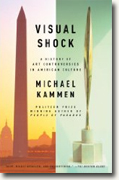Visual Shock
Michael Kammen
book reviews:
· general fiction
· chick lit/romance
· sci-fi/fantasy
· graphic novels
· nonfiction
· audio books
· author interviews
· children's books @
curledupkids.com
· DVD reviews @
curledupdvd.com
newsletter
win books
buy online
links
home
for authors
& publishers
for reviewers

 |
Visual Shock: A History of Art Controversies in American Culture Michael Kammen Vintage Paperback 480 pages November 2007 |
|
The subtitle of this exhausting but ultimately rewarding book is "A History of Art Controversies in American Culture." Since that can mean a number of things, let me clarify what Kammen means by it. Apart from a couple of amusing instances where controversy was provoked by an artist's eccentric behavior - Thomas Eakins, naked students, you get the picture - this book is about the reception of particular works or groups of works, where that reception has involved a significant degree of public debate. It doesn't matter whether the work in question is widely-known; most of the cases he describes aren't and never will be (many don't deserve to be). More important is whether the controversy under discussion illustrates one or more aspects of the half-dozen or so themes that Kammen has found running through every art-provoked controversy that has ever occurred during the entire history of the United States, every single one of which he has recounted in these pages.
Fortunately, every episode, without exception, is captivating. He might have illustrated his themes with just a handful of examples - and a book for a different kind of reader certainly would have - but it would have been much less fun that way, and the great value of this book lies in its deep level of detail. These episodes held my full attention despite the fact that Kammen's writing style, at best, is the most plodding and academic I've read anywhere outside of Artforum. (Actually, that's an unfair comparison; at least Kammen's writing always makes sense, however heavy with passive constructions it can get.) This combination of anti-style and painstaking detail makes for slow going: the book required several dozen hours to read instead of the eight or so I expected, and its nearly four hundred pages (not including notes) felt more like a thousand. It was almost like reading a dictionary cover-to-cover; in other words, it's an exercise for the serious student, one prepared to be fascinated by minutiae, and not for the casual reader. But this must be said: I didn't start out as such a student, and this book made me one. Kammen's great achievement actually lies in this heroic marshalling of anecdote and data. Each example of a particular type of controversy - whether the flash point was politics, sexuality, gender issues, race issues, or the central question of art's role in public life - adds another piece of context, another facet that contributes to the reader's understanding of the entire trend. Reality is not simple, in other words, and Kammen does us the service of not pretending otherwise. Moreover, he draws out parallels by means of juxtaposition, trusting the reader's intelligence enough to see the commonalities and the differences, and the argument thereby implied. This is welcome, because when Kammen does spell out a conclusion, it tends to be an exasperating summary of the data already presented, the kind of talk that ends the discussion with an unseemly lurch. This is nowhere more true than of the end of the text: contemporary art is infamous for being baffling, shocking, and controversial, and nobody needs to read nearly four hundred pages to arrive at Kammen's thuddingly obvious conclusion that visual art is likely to remain provocative so long as our society places such a premium on cultural dynamism. Like, duh, dude. But these are forgivable foibles. Having made the long journey from page one to the end, it is difficult to imagine a lighter treatment being anywhere near as useful. When controversies erupted in my own town, San Francisco, during the course of my reading, I was able to refer to this book and understand and explicate current events in terms of similar controversies going all the way back to the early 19th century. This kind of education is invaluable, and I know that Visual Shock Originally published on Curled Up With A Good Book at www.curledup.com. © Jeremy Hatch, 2008 |
|
|
|
 Click here to learn more about this month's sponsor! |
|
| fiction · sf/f · comic books · nonfiction · audio newsletter · free book contest · buy books online review index · links · · authors & publishers reviewers |
|
| site by ELBO Computing Resources, Inc. | |
 Or at least that's how it feels after reading it. If
Or at least that's how it feels after reading it. If